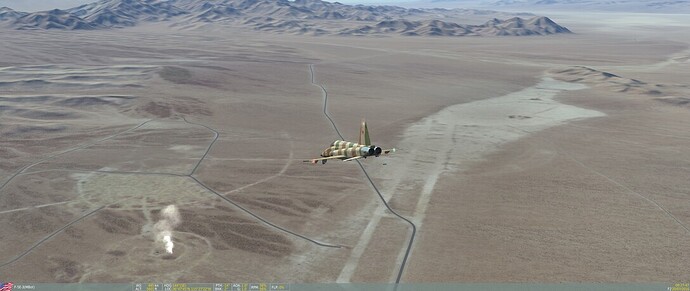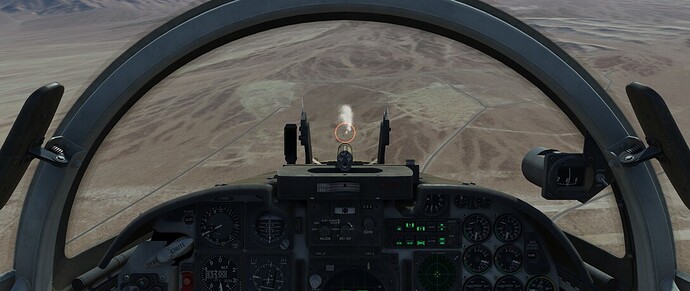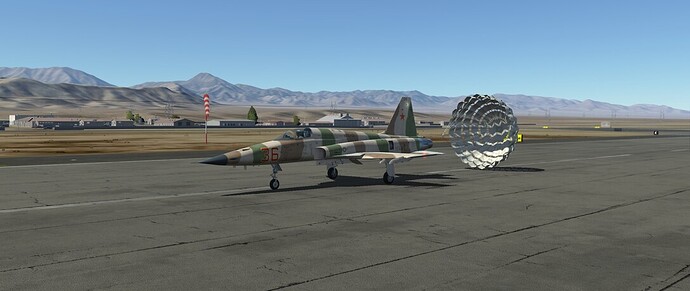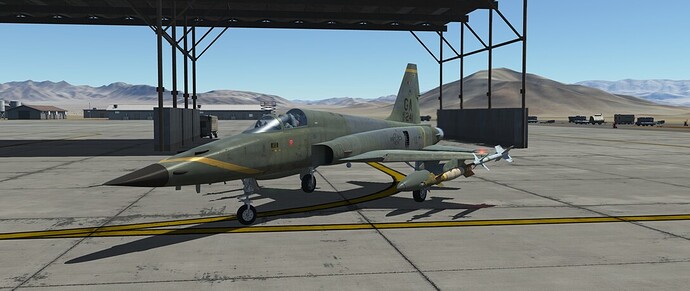On this flight we are going to train practice bomb deliveries with the F-5E on the NTTR.
Before departing we will have to do some planning first. We are going to drop BDU-33 practice bombs, which I understand have the ballistics of a the Mk-82 LDGP bomb. We select the first delivery profile with a dive angle of 15°, release speed of 480 KTAS and 1’500 ft above the target. This ensures that during pullout we will stay above the frag clearance altitude of 1’200 ft AGL. This delivery profile requires a sight depression of 109 MILS from flight path. This value still needs to be corrected for the AOA of the aircraft, and since the F-5E has a Zero Sight Line (from where the sight depression angle is applied) that is usually below the flight path, the AOA correction needs to be subtracted. Unfortunately the values from the real weapons delivery manual do not apply in DCS, so I usually apply a generic correction of -20. Therefore our sight depression will be 89 MILS.
Next we will have to review our target. Notice at the top left that the target has an elevation of 3’478 ft. Since our drop altitude is 1’500 ft above target, we make a mental note that our drop alt will be 5’000 ft MSL.
Next we have to determine our drop speed, which the profile specifies as 480 kts True Air Speed. This is depending on temperature. The temperature set for this mission is 31°C, which in DCS is at sea level. We will drop at 5’000 ft MSL and the temperature gradient is 2°C per thousand feet. An online calculator shows that 480 KTAS at 5’000 ft MSL and 21°C is 435 KIAS, which I mark with the speed bug on the air speed indicator.
Bombs are loaded, we are ready to go.
Departing Creech AFB.
The Nevada map and the F-5E match like “die Faust auf’s Auge”.
The circle below is our target.
In the base leg for the first bomb run. Now is a good time to make sure that all weapons witches are set correctly and to review the delivery parameters: 15°, 5’000 ft, 435 KIAS. good rule of thumb to get a 15° dive angle is to place it at the lower edge of the side mirror.
Rolling in.
Aiming the aircraft at the Aim Off Point beyond the target.
Rolling out and doing the initial pipper placement by putting the target roughly half-way between the flight path and the pipper. At this point I usually do a quick mental recap of the error corrections: Dropping SLOW gets a SHORT bomb, dropping SHALLOW gets a SHORT bomb, dropping LOW gets a LONG bomb.
Sight picture at drop, speed is slightly fast, which would require an early drop. Dive angle is spot on, requiring no correction. But altitude is too high (short bomb), therefore I decided to delay the release and aim a little long.
Notice the indicated altitude and the actual altitude at the top left. Unfortunately there is a fairly large altimeter lag which needs to be accounted for and further complicating bomb delivery. Hopefully Belsimtek will fix that bug sometimes.
Pullout with 5+ Gs.
Rolling over to observe the impact. The bomb lands 240 ft long, pretty much exactly where the pipper was at delivery. At pipper on target the altitude was too high (which would have resulted in a short bombs). At drop the pipper altitude was was at release alt and the pipper beyond the target, therefore the bomb also landed beyond target. Less drop delay should have been applied, somewhere half-ways between alt at pipper-on-target and planned release alt. I think we can do better than this.
Approaching for the second run.
Roll in.
Pulling the nose on the Aim Off Point and rolling the jet round it.
We rolled out too far to the right. Correction is needed.
Corrected to the left and making initial pipper placement. Dive angle looks good. Speed is too high, retarding throttle. Quick mental recap of delivery parameters and error corrections.
Shortly before drop (unfortunately I missed to do a screenshot at drop). Speed is 15 kts high (long bomb). Dive angle shows 5° steep (long bomb), but in fact is 3° shallow (short bomb). Apparently the ADI was not aligned well after the hard pull down (bug or normal?). Altitude is already low and getting lower until the drop low (short bomb).
Bomb away.
Bomb lands 120 ft short. Not bad.
Approaching for the 3rd pass. Again offset enough to let the target move to the lower edge of the mirror for that 15° dive angle.
Roll in.
Roll out.
Speed looks good. Dive angle looks good. Mental review of error corrections (low-long/high-short). This might be a good pass.
Pipper on target, but still too high. Delaying the drop.
Dropping now.
Bomb away.
Rolling over and waiting the observe the impact. Good bomb! About 60 ft long.
Setting up the fourth bomb run.
Roll in.
Putting the flight path beyond the target for the roll out.
Roll out and initial pipper placement.
Pipper on target. On speed. Too steep (long bomb), too high (short bomb). Delaying drop to correct.
Drop.
Bomb away.
Good bomb! About 50 ft long.
Turning in for the last attack.
On the base leg.
Roll in.
Coming down, slightly fast. Pulling back the throttle.
Pipper on target. Dive angle ok, speed fast (long bomb), altitude very high (short bomb). Delaying the drop.
Bomb drop. It is already clear by now that this won’t be a very good bomb.
Bomb away.
Pull out.
Yep, 300 ft long and worst bomb for today.
Time to head home.









































































































